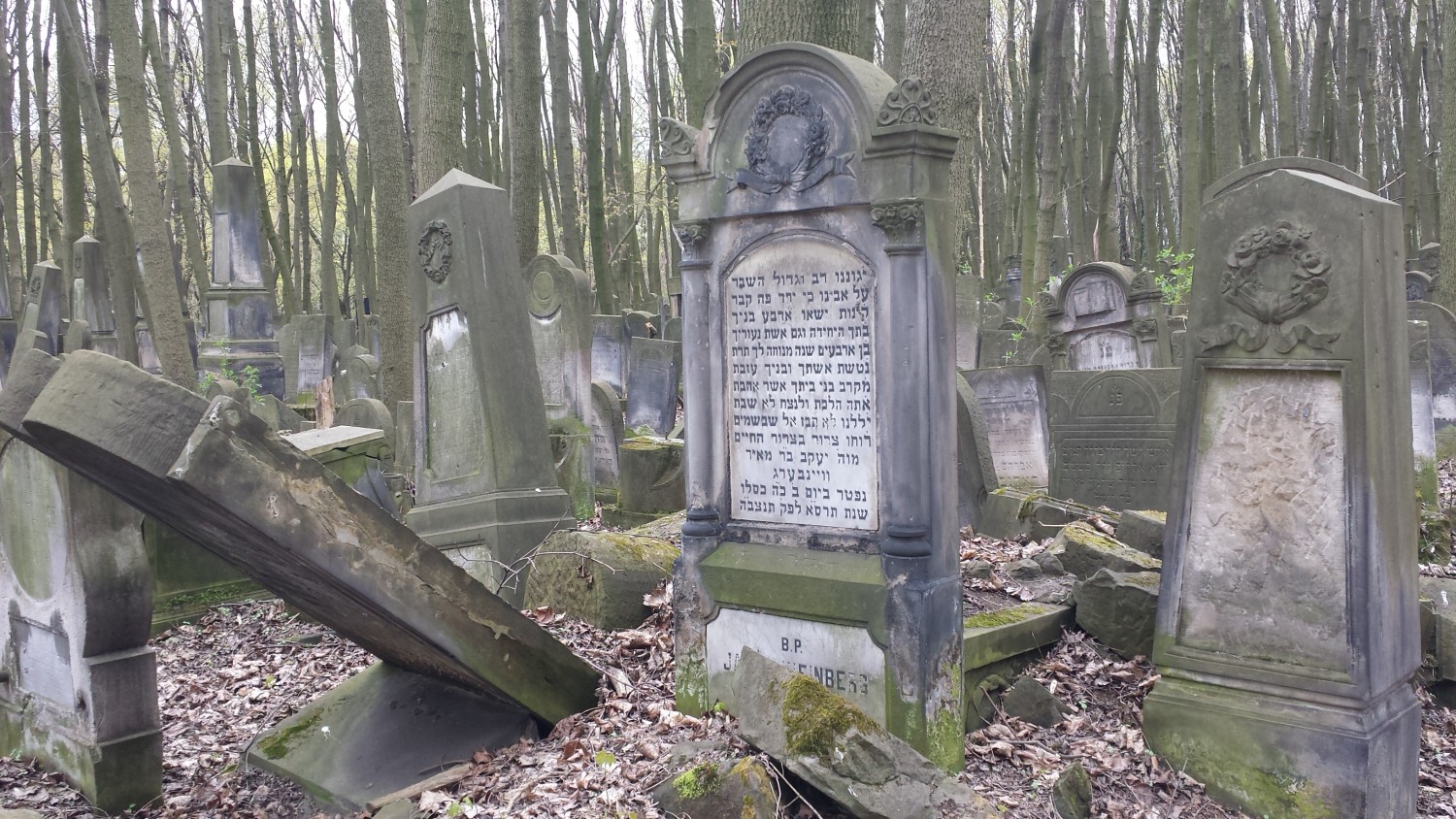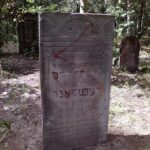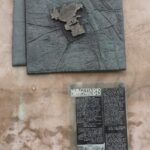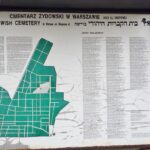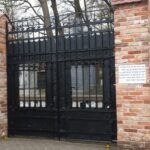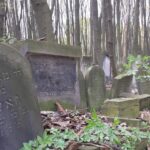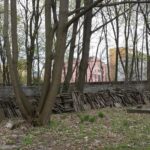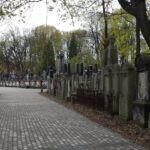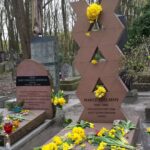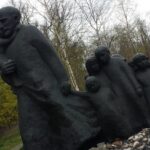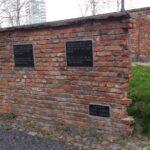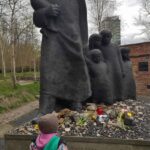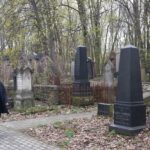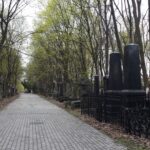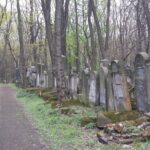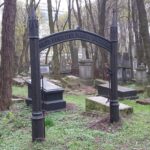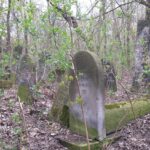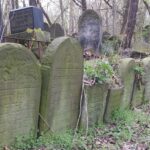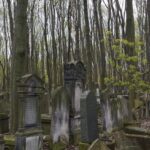There are actually a number of Jewish cemeteries in Warsaw, but the one at Okopowa street is by far the largest. At 83 acres or the size of about 63 football fields, it is also one of the largest Jewish cemeteries in Europe and one of the few remaining Jewish cemeteries in Poland still in operation (i.e. burials still take place there.) Founded in 1806 on the outskirts of the city, it served largely as the cemetery for Warsaw’s wealthy Jews; the city’s poorer Jews tended to be laid to rest at the much smaller Bródno cemetery on św. Wincentego street near the Praga district.
Their fates have also differed somewhat. Although 300,000 people are believed to have been buried at the Bródno cemetery, only about 3,000 marked graves remain, as the Nazis ransacked the tombstones (for a source of building materials) and because after the war the graveyard fell into decades of disuse, disrepair, and abandonment.
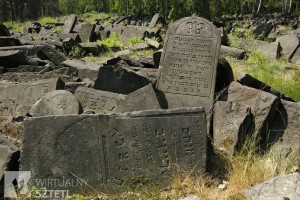
After the war in 1947, one final mass burial of Jews exhumed from the rubble of the city took place at Bródno. The cemetery was then closed in 1950. One year later, the communist administration planted a forest on the site of the cemetery and resumed the Nazi practice of using the cemetery as a quarry, i.e. using the headstones for the reconstruction of Warsaw. The walls and gates of the cemetery were destroyed in 1960, and the condition of the site deteriorated further.
Some order was restored in the 1980s when the then newly-formed Nissenbaum Family Foundation (dedicated to the preservation of Jewish sites and culture in Poland) began to take care of the site. The foundation erected an iron fence around the cemetery, installed monumental gates, and began the work of gathering and returning the headstones that had been dispersed around Warsaw.
Since the 1990s, the Jewish community has sent numerous requests to the city, asking that the headstones used at various sites across the city (such as the city zoo, city parks, the banks of the Vistula, etc.) be returned. Yet, in many instances the city hesitated (until recently), citing financial difficulties. Meanwhile, the park continued to be used as a meeting place for anti-Semitic, neo-Nazi gangs and the homeless.

In 2010, the Jewish community sent a letter to the media, describing the Bródno cemetery as follows: “the cemetery has become a place to walk animals, which is after all unacceptable in Catholic or secular cemeteries. In the cemetery there are plenty of empty liquor bottles, rubbish, dog poop, etc. The cemetery is a meeting place for a neo-Nazi gang. The entire front part of the lapidary is covered with anti-Semitic graffiti. Apart from Nazis, local social outcasts meet here to drink and to answer the call of nature (at the gate it smells of urine). The cemetery is not guarded, anyone can go in there – not only those who are curious about Jewish culture, but simple scum, drunks, people with dogs and, of course, the specific Nazi gangs.”
After causing a bit of stir in the media, a petition was started that called for the renovation and upkeep of the Bródno cemetery. The city pledged to start clean-up works, for which it will allocate 3 million zloty in the first stage (the money was actually given by the city as compensation for the land it took on Wawelberg Street.) The city also plans to renew the gate, clearly demarcate the original borders of the cemetery, bring order to the burgeoning forest, build paths, information boards and an information point, as well as install video cameras and renovate gravestones.
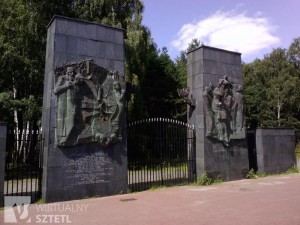
The renovation work was supposed to have begun in the last quarter of 2013 but it is unclear to me how much progress has been made as the gates to the cemetery have been sealed shut. Other blogs online seem indicate that there is a hole in the fence on the east side of the cemetery that the homeless still use to get into the cemetery and that it is still possible to get in via that route. I have yet to try it out for myself.
The Okopowa Street Cemetery
The Okopowa street cemetery, on the other hand, still contains over 150,000 of the original 250,000 marked graves (in addition to mass graves), albeit largely in utter disrepair. Nonetheless, after the war the Okopowa cemetery was reopened and a small portion of it continues to serve Warsaw’s tiny remaining Jewish population today.
Although sequestered from the rest of the city behind tall brick wall, the Okopowa street cemetery is one of the largest visible and tangible remains of Warsaw’s once vibrant Jewish community. In 1939, just before the outbreak of WWII, there were about 375,000 Jews living in Warsaw, or about one third of the city’s population. Warsaw was home to Europe’s largest metropolitan Jewish community – in fact, New York City was the only city in the world that had more Jewish residents at the time.
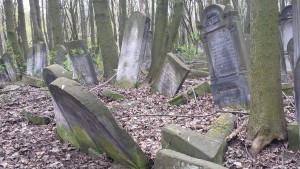
With this knowledge, it is somewhat eerie how purely Polish and Roman Catholic the Holocaust and decades of totalitarian Communist rule left Poland. Since then, however, Warsaw (and Poland, more generally) has been making serious strides to remember and reclaim its Jewish past. The new museum of Polish Jews, is one good example, as is the popular and Oscar-winning Polish film “Ida,” which tells the story of young Polish woman’s shocking discovery of her Jewish roots and her coming to terms with her suddenly personal relationship with Polish-Jewish history. Although not based on a true story, thousands of young Poles have experienced similar revelations regarding their family’s repressed Jewish past in recent years.
In many ways an allegory of the nation and its post-communist attempt to come to terms with its complicated history (as both victim and victimizer in some cases, for example), Ida can be understood as another “lieux de memoire,” “Erinnerungsort,” or “place of memory” in Poland’s ongoing sculpting of its memory landscape. Indeed, a number of these “places of memory” have begun in recent years to visibly alter the face of Warsaw. The exhibition “I Can Still See Their Faces,” (opened in 2008) displays the faces of former Jewish residents in the former Jewish district on Próżna street, for example, and the “Footbridge of Memory” lights up at night over Chłodna street to commemorate the footbridge that once stood in its place and connected the large and small Jewish ghettos during WWII.
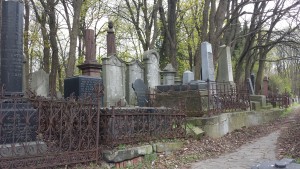
To experience more this for myself, this past weekend I went out in search of the largest depository of the physical remains (not monuments) of the once vibrant Jewish community in Warsaw. Unlike the Bródno cemetery that was, as aforementioned, used as a source of building materials, not only by the Nazis but also by the Communists in the postwar era, the Okopowa cemetery was simply confined to neglect. Most of the headstones remain, but the entire site has been overgrown with weeds, has become dilapidated, and is now enveloped under a canopy of new trees. The first few hundred meters that are still in use and made up of what are clearly more modern gravestones are largely free from trees but the further into the graveyard that I wandered, the denser the forest became. I was truly overcome by how completely abandoned the place felt, yet still rich in life and blossoming nature. The legacy of a bygone era, lost to nature and history, reminded me of the paintings of overgrown castles that inspired gothic revival art in the Romantic era.
In any case, I’m not sure how different the experience would be for those who visit the cemetery as part of a guided tour since I went alone. For me, there was very little contextualization aside from the research that I had done ahead of my visit and the singular sign (in English, Polish and Hebrew) at the entrance to the cemetery.
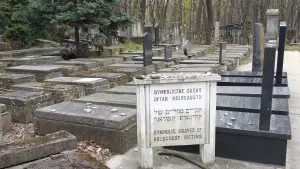
Nonetheless, I was able to find a number of monuments and memorials within the cemetery. The first that I found was actually located on the outer wall before the entrance and showed (and described in Polish) how the wall of the cemetery had served as the western wall of the Warsaw Ghetto during WWII. A second monument was a symbolic mass grave that consisted of sectioned off, unmarked tombs dedicated to the victims of the Holocaust.
Another monument was funded by private donations and dedicated to Janusz Korczak, a director of a Jewish orphanage before WWII. Apparently, when the Nazis came to round up the children and send them to Treblinka concentration camp, Korczak (despite having been offered amnesty for unknown reasons) refused to abandon his children and stayed with them until they all presumably were executed at the Treblinka Death Camp.
The final and most prominent monument that I found on the site of the Okopowa Jewish Cemetery was also funded by a private donation – this time from Jack P. Eisner. Eisner was a holocaust survivor from the Warsaw ghetto who escaped to New York, where became a self-made millionaire and spent enormous amounts of money spreading the story of the Holocaust, both privately and as president of the Holocaust Survivors Memorial Foundation.
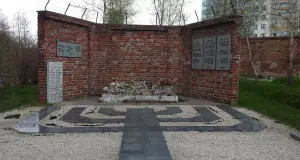
The monument in the Okopowa cemetery is dedicated to the children victims of the Holocaust, a very personal tragedy for Eisner as an inscription on a plaque at the monument makes clear: “My grandma Masza had twenty grandchildren, my grandma Hana had eleven of them. I was the only one to survive. Jacek Eisner.” Paving stones in the shape of a menorah lead to a triangular piece of recreated ghetto wall, complete with barbed wire. Underneath the wall are pictures of children amongst stones with the inscription in English, Polish, and Hebrew, “In memory of one million Jewish children murdered by Nazi German barbarians, 1939-1945. Jack Eisner, founder, sponsor.” The final wall of the monument is adorned with a poem by Henryka Łazowertówka, entitled “Mały Szmugler” or “Little Smuggler.” The English translation is as follows:
Through a hole, through a crack or a cranny
Starving yet stubborn and canny
Sneaking and speedy like a cat
I daily risk my youthful neck
And if fate will turn against me
In that game of life and bread
Do not weep for me mother; do not cry
Are we not all marked to die?
Only one worry besets me
Lying in agony; so nearly dead
Who’ll care for you tomorrow
Who’ll bring you, dear mom,
A slice of bread
Henryka Łazowertówka, 1941
In sum, the Okopowa cemetery is – like most cemeteries – a heterogenic collection of various, independent sites of memory, albeit shaped in the most visible monuments by the common experience of the Holocaust. Nonetheless, even though the cemetery is owned and maintained by Warsaw’s Jewish community, there doesn’t seem to be a common interpretation of that shared experience and history. Rather, the complex site (of one of the few remaining, tangible remains of Warsaw’s once large Jewish community) displays a multiplicity of individual experiences that have yet to be negotiated into a collective story or history.
Jewish Cemetery in Warsaw / Cmentarz żydowski w Warszawie
ul. Okopowa 49/51, Warszawa tel. 22 838 26 22
https://warszawa.jewish.org.pl/en/for-visitors/warsaw/okopowa/
Mon-Thurs: 10am-5pm (or dark)
Fri: 9am-1pm ; Sun 11am-4pm
Saturday closed

